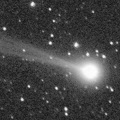
|
It brightened very rapidly as predicted. Now it is very bright as 6.3 mag (Jan. 6, Maik Meyer). It will approach to the earth down to 0.08 a.u. to the earth in mid February, and it will be observable at 6 mag in good condition. Now it is not observable. It will appear in the morning sky in early February, then it keeps observable in good condition after mid February.
Date(TT) R.A. (2000) Decl. Delta r Elong. m1 Best Time(A, h)
Jan. 21 21 3.39 -12 35.2 0.313 0.685 14 7.0 18:45 ( 78, -4)
Jan. 28 20 39.14 -8 20.8 0.212 0.777 9 7.0 5:34 (272,-12)
|
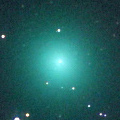
|
It brightened rapidly up to 6.8 mag (Jan. 6, Katsumi Yoshimoto). It approached to the sun down to 0.3 a.u. on Jan. 14. Now it is not observable. It is not observable after this in the Northern Hemisphere. In the Southern Hemisphere, it will appear in the extremely low sky in the evening in late February.
Date(TT) R.A. (2000) Decl. Delta r Elong. m1 Best Time(A, h)
Jan. 21 19 36.14 -27 54.3 1.292 0.381 11 7.4 5:37 (294,-15)
Jan. 28 20 34.61 -32 12.5 1.411 0.515 14 8.9 5:34 (294,-23)
|
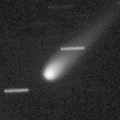
|
Now it is 10.9 mag (Jan. 20, Thomas Lehmann). It is expected to brighten up to 7 mag in summer. In the Northern Hemisphere, it keeps observable in good condition until the highlight while the comet will be brightening. In the Southern Hemisphere, it will be observable in spring, but it keeps very low for a while.
Date(TT) R.A. (2000) Decl. Delta r Elong. m1 Best Time(A, h)
Jan. 21 15 14.16 44 15.4 2.197 2.460 93 10.3 5:37 (236, 70)
Jan. 28 15 27.54 44 27.9 2.103 2.397 94 10.1 5:34 (233, 71)
|

|
Already bright as 11.4 mag (Jan. 19, Thomas Lehmann). It will pass the perihelion on Mar. 10. In the Northern Hemisphere, it keeps observable in the evening sky until late February while the comet will be brightening up to 8.5 mag. In the Southern Hemisphere, it will appear in the morning sky in late March at 8 mag, then it keeps observable while the comet will be fading.
Date(TT) R.A. (2000) Decl. Delta r Elong. m1 Best Time(A, h)
Jan. 21 23 22.10 5 20.9 1.354 1.095 53 11.4 18:45 ( 70, 34)
Jan. 28 23 31.32 5 60.0 1.303 0.980 48 10.8 18:51 ( 75, 30)
|
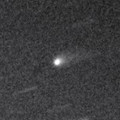
|
Now it is 12.0 mag (Jan. 18, Thomas Lehmann). It is expected to brighten up to 7 mag in spring. But it locates somewhat low at the high light.
Date(TT) R.A. (2000) Decl. Delta r Elong. m1 Best Time(A, h)
Jan. 21 15 55.71 -22 14.9 2.300 1.989 59 11.3 5:37 (325, 24)
Jan. 28 16 15.20 -22 54.9 2.158 1.906 62 11.0 5:34 (327, 24)
|

|
Now it is 14.2 mag (Jan. 6, Ken-ichi Kadota). It will brighten up to 12 mag from winter to spring. In the Northern Hemisphere, it keeps observable while the comet is brightening gradually. But it will be unobservable in late February. In the Southern Hemisphere, it keeps observable for a long time after this.
Date(TT) R.A. (2000) Decl. Delta r Elong. m1 Best Time(A, h)
Jan. 21 16 27.99 -15 37.2 1.540 1.237 53 12.7 5:37 (314, 25)
Jan. 28 16 59.59 -17 24.1 1.483 1.182 52 12.5 5:34 (314, 23)
|

|
Now it is not observable. It will appear in the morning sky in March.
Date(TT) R.A. (2000) Decl. Delta r Elong. m1 Best Time(A, h)
Jan. 21 20 26.68 -20 18.5 6.853 5.871 3 13.9 18:45 ( 76,-16)
Jan. 28 20 32.55 -19 53.7 6.853 5.869 2 13.9 5:34 (283,-17)
|
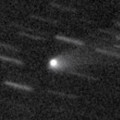
|
Now it is 14.2 mag (Jan. 20, Thomas Lehmann). It will brighten up to 14 mag from winter to spring, and it will be observable in excellent condition in the Northern Hemisphere. It keeps low in the Southern Hemisphere.
Date(TT) R.A. (2000) Decl. Delta r Elong. m1 Best Time(A, h)
Jan. 21 12 4.05 27 37.1 1.726 2.447 126 14.1 4:03 ( 0, 82)
Jan. 28 12 6.16 28 27.3 1.682 2.456 132 14.1 3:38 ( 0, 83)
|

|
Now it is 13.7 mag (Jan. 19, Thomas Lehmann). It will approach to the earth down to 0.14 a.u. from March to April. It is expected to brighten up to 5-6 mag. It may brighten furthermore in outburst. In the Northern Hemisphere, it keeps observable in excellent condition. In the Southern Hemisphere, it will not be observable for about one month around the highlight. But it keeps observable in good condition except for that period.
Date(TT) R.A. (2000) Decl. Delta r Elong. m1 Best Time(A, h)
Jan. 21 9 28.70 8 40.4 0.527 1.486 158 15.2 1:28 ( 0, 64)
Jan. 28 9 30.69 10 2.0 0.454 1.429 165 14.6 1:03 ( 0, 65)
|

|
Now it is 14.3 mag (Dec. 31, Jakub Cerny). Distant object, but it keeps observable at 13-14 mag for a long time from 2015 to 2016.
Date(TT) R.A. (2000) Decl. Delta r Elong. m1 Best Time(A, h)
Jan. 21 0 53.92 -3 42.9 5.429 5.180 70 14.8 18:45 ( 41, 43)
Jan. 28 0 58.45 -3 17.5 5.545 5.197 64 14.9 18:51 ( 49, 39)
|

|
Now it is bright as 14.4 mag (Jan. 14, Thomas Lehmann). It will be observable at 11 mag for a long time from 2017 to 2018. Now it is observable in excellent condition in the Southern Hemisphere. But it keeps low for a while in the Northern Hemisphere.
Date(TT) R.A. (2000) Decl. Delta r Elong. m1 Best Time(A, h)
Jan. 21 2 46.62 -33 11.0 5.276 5.299 85 14.9 18:45 ( 0, 22)
Jan. 28 2 46.60 -31 49.5 5.300 5.246 81 14.8 18:51 ( 8, 23)
|

|
Now it is 14.8 mag (Dec. 31, Yuji Ohshima). It keeps 15 mag until spring. But it will be getting lower gradually after this.
Date(TT) R.A. (2000) Decl. Delta r Elong. m1 Best Time(A, h)
Jan. 21 23 53.72 8 37.9 1.989 1.748 61 15.2 18:45 ( 67, 43)
Jan. 28 0 9.46 10 31.3 2.025 1.733 58 15.1 18:51 ( 73, 40)
|

|
It has not been observed yet in this apparition. The condition of this apparition is worst. It will brighten up to 10 mag in spring, but not observable at all.
Date(TT) R.A. (2000) Decl. Delta r Elong. m1 Best Time(A, h)
Jan. 21 20 58.21 -8 30.7 2.504 1.581 15 15.6 18:45 ( 82, -3)
Jan. 28 21 17.69 -7 21.5 2.458 1.521 13 15.2 18:51 ( 85, -5)
|
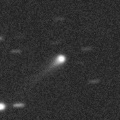
|
It brightened very rapidly up to 12 mag in autumn, brighter than originally expected. It will not be observable after this.
Date(TT) R.A. (2000) Decl. Delta r Elong. m1 Best Time(A, h)
Jan. 21 20 30.11 -9 55.8 3.099 2.141 10 15.3 18:45 ( 84, -9)
Jan. 28 20 45.54 -8 44.6 3.127 2.162 9 15.6 18:51 ( 88,-12)
|
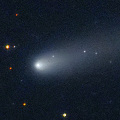
|
It brightened up to 11-12 mag from summer to autumn. Now it is fading. But it is bright as 12.4 mag still now (Dec. 29, Jakub Cerny).
Date(TT) R.A. (2000) Decl. Delta r Elong. m1 Best Time(A, h)
Jan. 21 12 30.25 -25 19.0 1.660 2.108 102 15.3 4:29 ( 0, 30)
Jan. 28 12 31.26 -26 14.6 1.629 2.157 108 15.4 4:03 ( 0, 29)
|

|
It brightened up to 11 mag from spring to summer in 2016. Now it is not observable. It will be observable at 16 mag again in spring.
Date(TT) R.A. (2000) Decl. Delta r Elong. m1 Best Time(A, h)
Jan. 21 18 15.90 -21 28.0 3.164 2.334 27 15.3 5:37 (299, 3)
Jan. 28 18 29.67 -21 21.3 3.162 2.375 31 15.4 5:34 (301, 5)
|
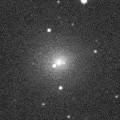
|
It brightened up to 11-12 mag in autumn. Now it is fading. But it is bright as 12.5 mag still now (Jan. 7, Thomas Lehmann).
Date(TT) R.A. (2000) Decl. Delta r Elong. m1 Best Time(A, h)
Jan. 21 13 42.80 -15 13.0 1.819 2.092 91 15.3 5:37 (359, 40)
Jan. 28 13 48.27 -15 49.8 1.781 2.141 97 15.5 5:19 ( 0, 39)
|

|
Now it is 15.8 mag (Jan. 1, Ken-ichi Kadota). It will brighten up to 12-13 mag and will be observable in good condition in summer. In this winter, it is observable until mid January in the Southern Hemisphere, or until the end of February in the Northern Hemisphere.
Date(TT) R.A. (2000) Decl. Delta r Elong. m1 Best Time(A, h)
Jan. 21 0 9.90 14 56.5 3.770 3.522 67 15.4 18:45 ( 71, 49)
Jan. 28 0 8.51 14 24.7 3.856 3.479 60 15.4 18:51 ( 77, 42)
|

|
Now it is 15.7 mag (Jan. 4, T. Ikemura, H. Sato). It will brighten up to 14 mag from spring to summer in 2017. It locates somewhat low in the Northern Hemisphere. The perihelion distance increased from 2.4 a.u. to 2.9 a.u. in this apparition. So it will not be bright as before.
Date(TT) R.A. (2000) Decl. Delta r Elong. m1 Best Time(A, h)
Jan. 21 15 38.18 -16 9.5 3.482 3.191 64 15.6 5:37 (326, 31)
Jan. 28 15 46.21 -16 42.2 3.378 3.178 69 15.5 5:34 (330, 33)
|

|
Now it is 15.3 mag (Dec. 29, Kunihiro Shima). It will brighten up to 14 mag from summer to next winter. Then it will be observable in excellent condition in the Northern Hemisphere. In the Southern Hemisphere, it is hardly observable around the highlight.
Date(TT) R.A. (2000) Decl. Delta r Elong. m1 Best Time(A, h)
Jan. 21 22 59.56 -1 38.6 4.549 3.912 44 15.7 18:45 ( 68, 25)
Jan. 28 23 3.19 -0 20.9 4.590 3.875 39 15.7 18:51 ( 75, 20)
|

|
Now it is 15.6 mag (Jan. 9, J. L. Martin). It will be observable at 16-17 mag in good condition from autumn to winter. It locates low in the Southern Hemisphere.
Date(TT) R.A. (2000) Decl. Delta r Elong. m1 Best Time(A, h)
Jan. 21 6 57.79 27 19.4 2.809 3.755 161 15.7 22:53 ( 0, 82)
Jan. 28 6 53.25 27 29.5 2.840 3.747 153 15.7 22:21 ( 0, 82)
|

|
Now it is 17.2 mag (Jan. 6, Hiroshi Abe). It will brighten up to 10 mag in summer, and it will be observable in excellent condition in the Southern Hemisphere. It locates low in the Northern Hemisphere.
Date(TT) R.A. (2000) Decl. Delta r Elong. m1 Best Time(A, h)
Jan. 21 14 33.73 -7 13.5 2.036 2.144 82 16.0 5:37 (340, 46)
Jan. 28 14 45.55 -8 9.2 1.922 2.106 86 15.7 5:34 (345, 46)
|
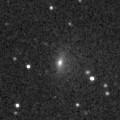
|
Now it is 15.7 mag (Dec. 30, Sandor Szabo). It keeps 16-17 mag for a long time from 2016 to 2019. It keeps locating near by the equator.
Date(TT) R.A. (2000) Decl. Delta r Elong. m1 Best Time(A, h)
Jan. 21 9 17.55 2 16.4 8.735 9.644 156 15.9 1:17 ( 0, 57)
Jan. 28 9 15.98 2 30.8 8.697 9.639 162 15.9 0:48 ( 0, 57)
|

|
It brightened up to 6 mag from last autumn to last winter. Now it is fading. It has already faded down to 16.0 mag (Jan. 1, Yuji Ohshima). It is observable in good condition in the Northern Hemisphere. It is not observable after this in the Southern Hemisphere.
Date(TT) R.A. (2000) Decl. Delta r Elong. m1 Best Time(A, h)
Jan. 21 2 58.10 48 56.1 5.136 5.585 112 16.0 18:55 (180, 76)
Jan. 28 2 55.73 48 0.2 5.303 5.651 105 16.1 18:51 (162, 76)
|

|
It kept bright 12 mag for a long time from autum in 2015 to summer in 2016. Now it is fading. It has already faded dwon to 15.6 mag (Jan. 6, Hiroshi Abe). It is appearing in the morning sky in the Northern Hemispehre. It will be observable in late January also in the Southern Hemisphere.
Date(TT) R.A. (2000) Decl. Delta r Elong. m1 Best Time(A, h)
Jan. 21 17 10.54 -4 18.6 4.758 4.149 46 16.0 5:37 (297, 27)
Jan. 28 17 14.29 -4 49.5 4.727 4.199 52 16.1 5:34 (302, 30)
|

|
It was observed at 16 mag from spring to summer in 2016. It will be observable at 16 mag also in 2017 from winter to spring.
Date(TT) R.A. (2000) Decl. Delta r Elong. m1 Best Time(A, h)
Jan. 21 17 10.32 -10 9.0 3.859 3.238 44 16.1 5:37 (302, 23)
Jan. 28 17 19.72 -9 1.2 3.795 3.248 49 16.1 5:34 (304, 26)
|

|
Appearing in the morning sky. Now it is fading. But it must be bright as 16 mag still now.
Date(TT) R.A. (2000) Decl. Delta r Elong. m1 Best Time(A, h)
Jan. 21 16 15.92 -20 52.0 2.866 2.441 55 16.2 5:37 (320, 23)
Jan. 28 16 26.15 -20 55.4 2.857 2.512 59 16.3 5:34 (323, 25)
|

|
Now it is 16.5 mag (Dec. 29, Sandor Szabo). It will brighten up to 15 mag and will be observable in good condition from autum to winter in 2017. In the Northern Hemisphere, it keeps observable in good condition for a long time while the comet will be brightening. It is not observable until 2017 summer in the Southern Hemisphere.
Date(TT) R.A. (2000) Decl. Delta r Elong. m1 Best Time(A, h)
Jan. 21 1 56.14 44 28.0 4.775 5.056 101 16.4 18:45 (137, 76)
Jan. 28 1 54.01 42 58.9 4.861 5.027 94 16.4 18:51 (122, 71)
|
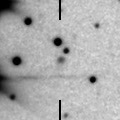
|
Now it is 16.4 mag (Jan. 3, T. Ikemura, H. Sato). It keeps 16 mag for a long time from 2017 to 2018.
Date(TT) R.A. (2000) Decl. Delta r Elong. m1 Best Time(A, h)
Jan. 21 9 17.14 -7 59.6 4.934 5.791 147 16.6 1:17 ( 0, 47)
Jan. 28 9 10.93 -6 59.0 4.871 5.771 153 16.6 0:43 ( 0, 48)
|

|
Now it is 16.5 mag (Dec. 26, A. Diepvens). It keeps 16.5 mag from 2016 to 2017. In the Northern Hemisphere, it keeps observable in good condition for a long time. In the Southern Hemisphere, it will never be observable again.
Date(TT) R.A. (2000) Decl. Delta r Elong. m1 Best Time(A, h)
Jan. 21 18 8.13 37 40.5 6.609 6.251 64 16.6 5:37 (246, 37)
Jan. 28 18 14.34 38 40.3 6.579 6.253 66 16.6 5:34 (246, 41)
|
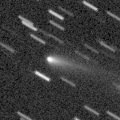
|
It brightened up to 14.6 mag from autum to winter (Dec. 2, Kunihiro Shima). Now it is fading. It has already faded down to 16.3 mag (Jan. 5, E. Bryssinck). It will be fainter than 18 mag in March.
Date(TT) R.A. (2000) Decl. Delta r Elong. m1 Best Time(A, h)
Jan. 21 4 5.10 31 35.6 2.210 2.876 123 16.8 20:02 ( 0, 87)
Jan. 28 4 7.90 31 16.8 2.312 2.901 117 17.0 19:37 ( 0, 86)
|

|
Now it is 16.8 mag (Jan. 6, D. Buczynski). It is expected to brighten up to 9 mag in summer in 2018. In the Northern Hemisphere, it keeps observable until 2018 summer while the comet will be brightening. In the Southern Hemisphere, it is hardly observable in 2017, but it will be observable in good condition in 2018.
Date(TT) R.A. (2000) Decl. Delta r Elong. m1 Best Time(A, h)
Jan. 21 18 33.85 44 53.2 6.367 6.078 68 16.9 5:37 (236, 35)
Jan. 28 18 39.47 44 54.9 6.305 6.023 69 16.8 5:34 (237, 38)
|

|
It brightened up to 15 mag in early 2016. Now it is fading. It has already faded down to 16.3 mag (Dec. 30, Sandor Szabo). In the Northern Hemisphere, it keeps observable in good condition for a long time until 2017 autumn when the comet will be fainter than 18 mag. It will never be observable after this in the Southern Hemisphere.
Date(TT) R.A. (2000) Decl. Delta r Elong. m1 Best Time(A, h)
Jan. 21 15 28.72 67 35.3 5.988 6.258 101 16.9 5:37 (197, 54)
Jan. 28 15 32.66 68 5.8 6.002 6.286 102 16.9 5:34 (194, 55)
|
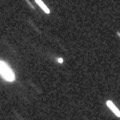
|
Now it is 17.1 mag (Jan. 9, ATLAS-HKO, Haleakala). It brightened rapidly, and became brighter than originally expected. It keeps 17 mag until 2017. In the Northern Hemisphere, it keeps observable in excellent condition for a long time. It is not observable in the Southern Hemisphere.
Date(TT) R.A. (2000) Decl. Delta r Elong. m1 Best Time(A, h)
Jan. 21 13 39.38 57 59.6 6.939 7.352 111 16.9 5:37 (180, 67)
Jan. 28 13 35.13 58 38.9 6.900 7.358 114 16.9 5:06 (180, 66)
|

|
Now it is 16.1 mag (Dec. 30, Yuji Ohshima). In the Northern Hemisphere, it will be observable at 17 mag in excellent condition in winter. It locates low in the Southern Hemisphere.
Date(TT) R.A. (2000) Decl. Delta r Elong. m1 Best Time(A, h)
Jan. 21 6 50.14 34 52.5 2.509 3.434 156 16.9 22:46 ( 0, 90)
Jan. 28 6 46.59 34 41.6 2.557 3.443 149 17.0 22:15 ( 0, 90)
|
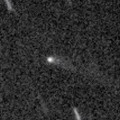
|
Now it is 17.2 mag (Jan. 8, D. Buczynski). It was observed at 17 mag last winter. It will be observable at 17 mag again next winter. It is observable in good condition in the Northern Hemisphere. But it locates low in the Southern Hemisphere.
Date(TT) R.A. (2000) Decl. Delta r Elong. m1 Best Time(A, h)
Jan. 21 11 27.40 27 33.4 3.243 4.000 135 17.1 3:27 ( 0, 82)
Jan. 28 11 26.65 29 24.9 3.212 4.024 140 17.1 2:58 ( 0, 84)
|

|
Now it is 18.2 mag (Dec. 6, T. Ikemura, H. Sato). It was expected to be observable at 17 mag in good condition in winter. But actually, it is fainter than this ephemeris.
Date(TT) R.A. (2000) Decl. Delta r Elong. m1 Best Time(A, h)
Jan. 21 12 47.40 -1 24.8 2.068 2.569 109 17.2 4:46 ( 0, 53)
Jan. 28 12 49.73 -1 10.3 2.011 2.599 116 17.2 4:21 ( 0, 54)
|

|
It will pass the perihelion in 2019. However, it has not been brightening since the discovery in 2010. Now it is 17.1 mag (Jan. 4, T. Ikemura, H. Sato). It keeps observable in excellent condition in the Northern Hemisphere. It is not observable in the Southern Hemisphere.
Date(TT) R.A. (2000) Decl. Delta r Elong. m1 Best Time(A, h)
Jan. 21 3 44.24 61 24.8 9.057 9.564 118 17.2 19:41 (180, 64)
Jan. 28 3 42.75 61 11.5 9.113 9.545 113 17.2 19:12 (180, 64)
|
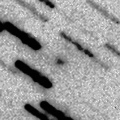
|
Now it is 17.2 mag (Dec. 30, A. Diepvens). In the Northern Hemisphere, it is observable at 17-18 mag until March. It is not observable in the Southern Hemisphere.
Date(TT) R.A. (2000) Decl. Delta r Elong. m1 Best Time(A, h)
Jan. 21 18 33.29 53 43.5 1.899 1.928 76 17.2 5:37 (225, 37)
Jan. 28 18 34.08 56 52.6 1.859 1.942 79 17.2 5:34 (222, 41)
|

|
It brightened up to 8-9 mag from winter to spring in 2016. Now it is fading. It has already faded down to 17.1 mag (Dec. 6, T. Ikemura, H. Sato).
Date(TT) R.A. (2000) Decl. Delta r Elong. m1 Best Time(A, h)
Jan. 21 13 14.12 -13 21.6 4.550 4.798 98 17.2 5:13 ( 0, 42)
Jan. 28 13 12.29 -13 57.3 4.492 4.856 105 17.3 4:44 ( 0, 41)
|
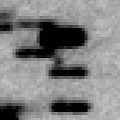
|
Now it is 17.7 mag (Jan. 7, Mt. Lemmon Survey). It will be observable at 17.5 mag in good condition from winter to spring.
Date(TT) R.A. (2000) Decl. Delta r Elong. m1 Best Time(A, h)
Jan. 21 14 29.03 -8 54.2 2.207 2.306 83 17.4 5:37 (342, 44)
Jan. 28 14 37.94 -9 33.2 2.136 2.319 87 17.4 5:34 (348, 45)
|

|
Now it is 17.3 mag (Jan. 8, CAO, San Pedro de Atacama). It is observable at 17.5 mag in good condition in this winter in the Southern Hemisphere.
Date(TT) R.A. (2000) Decl. Delta r Elong. m1 Best Time(A, h)
Jan. 21 6 25.15 -46 59.3 3.429 3.860 108 17.5 22:20 ( 0, 8)
Jan. 28 6 14.81 -44 38.3 3.429 3.860 108 17.5 21:42 ( 0, 11)
|

|
It brightened up to 6.2 mag in June in 2016 (June 24, Marco Goiato). Now it is fading. It has already faded down to 17.1 mag (Jan. 6, B. Lutkenhoner, W. F. Cashwell). In the Southern Hemisphee, it keeps observable in excellent condition after this. It keeps low in the Northern Hemisphere.
Date(TT) R.A. (2000) Decl. Delta r Elong. m1 Best Time(A, h)
Jan. 21 15 4.98 -33 43.7 4.025 3.777 68 17.6 5:37 (341, 18)
Jan. 28 15 2.48 -34 6.9 3.970 3.847 75 17.7 5:34 (347, 19)
|
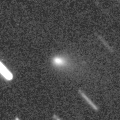
|
It had been lost for a long time over 200 years since its discovery in 1783. It brightened rapidly, and reached up to 13.9 mag in autumn (Spet. 1, Sandor Szabo). Now it is fading. But it is bright as 16.1 mag still now (Jan. 7, D. Buczynski). It may keep 16-17 mag for some more time. It is observable in excellent condition for a while in the Northern Hemisphere. It is not observable after this in the Southern Hemisphere.
Date(TT) R.A. (2000) Decl. Delta r Elong. m1 Best Time(A, h)
Jan. 21 2 57.66 59 2.8 1.590 2.170 112 17.7 18:55 (180, 66)
Jan. 28 3 1.07 59 5.6 1.691 2.205 108 18.0 18:51 (174, 66)
|
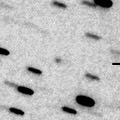
|
Now it is 18.9 mag (Dec. 27, K. Hills). It is observable at 18 mag in good condition from January to March.
Date(TT) R.A. (2000) Decl. Delta r Elong. m1 Best Time(A, h)
Jan. 21 10 51.47 -7 1.1 2.388 3.137 132 17.9 2:51 ( 0, 48)
Jan. 28 10 48.96 -7 34.7 2.342 3.155 139 17.8 2:21 ( 0, 47)
|
|
![]()
 237P/LINEAR
237P/LINEAR 43P/Wolf-Harrington
43P/Wolf-Harrington 81P/Wild 2
81P/Wild 2 144P/Kushida
144P/Kushida C/2015 VL62 ( Lemmon-Yeung-PanSTARRS )
C/2015 VL62 ( Lemmon-Yeung-PanSTARRS ) 65P/Gunn
65P/Gunn C/2016 N4 ( MASTER )
C/2016 N4 ( MASTER ) 74P/Smirnova-Chernykh
74P/Smirnova-Chernykh 71P/Clark
71P/Clark C/2014 B1 ( Schwartz )
C/2014 B1 ( Schwartz ) C/2013 US10 ( Catalina )
C/2013 US10 ( Catalina ) C/2014 W2 ( PanSTARRS )
C/2014 W2 ( PanSTARRS ) C/2016 B1 ( NEOWISE )
C/2016 B1 ( NEOWISE ) C/2015 TQ209 ( LINEAR )
C/2015 TQ209 ( LINEAR ) C/2015 V1 ( PanSTARRS )
C/2015 V1 ( PanSTARRS ) C/2016 A1 ( PanSTARRS )
C/2016 A1 ( PanSTARRS ) C/2014 OE4 ( PanSTARRS )
C/2014 OE4 ( PanSTARRS ) 56P/Slaughter-Burnham
56P/Slaughter-Burnham C/2016 M1 ( PanSTARRS )
C/2016 M1 ( PanSTARRS ) C/2013 V4 ( Catalina )
C/2013 V4 ( Catalina ) C/2014 R3 ( PanSTARRS )
C/2014 R3 ( PanSTARRS ) P/2015 TP200 ( LINEAR )
P/2015 TP200 ( LINEAR ) C/2015 X7 ( ATLAS )
C/2015 X7 ( ATLAS ) 118P/Shoemaker-Levy 4
118P/Shoemaker-Levy 4 C/2010 U3 ( Boattini )
C/2010 U3 ( Boattini ) C/2016 T2 ( Matheny )
C/2016 T2 ( Matheny ) C/2014 S2 ( PanSTARRS )
C/2014 S2 ( PanSTARRS ) 94P/Russell 4
94P/Russell 4 C/2017 A3 ( Elenin )
C/2017 A3 ( Elenin ) C/2013 X1 ( PanSTARRS )
C/2013 X1 ( PanSTARRS ) 226P/Pigott-LINEAR-Kowalski
226P/Pigott-LINEAR-Kowalski 330P/2015 U1 ( Catalina )
330P/2015 U1 ( Catalina )![]()









































